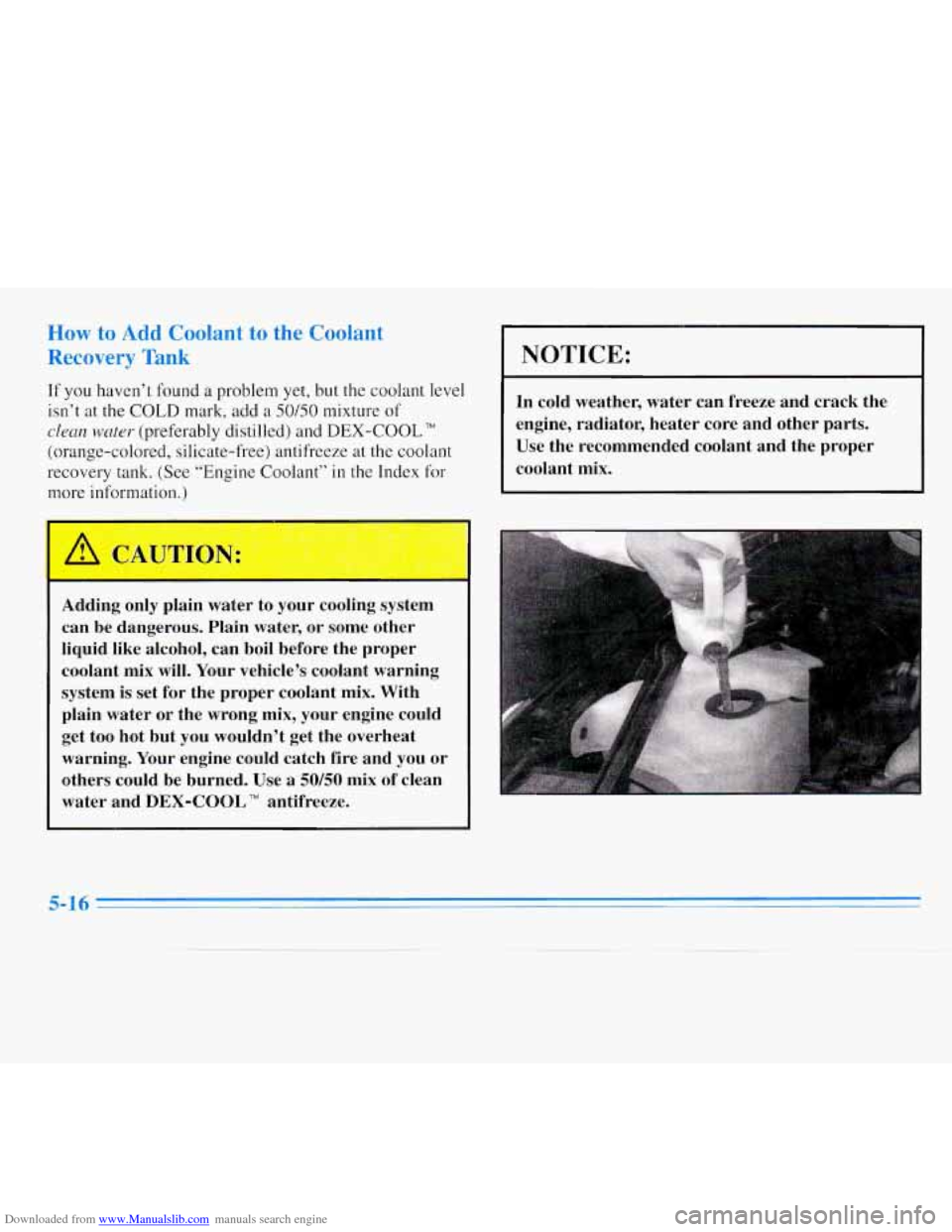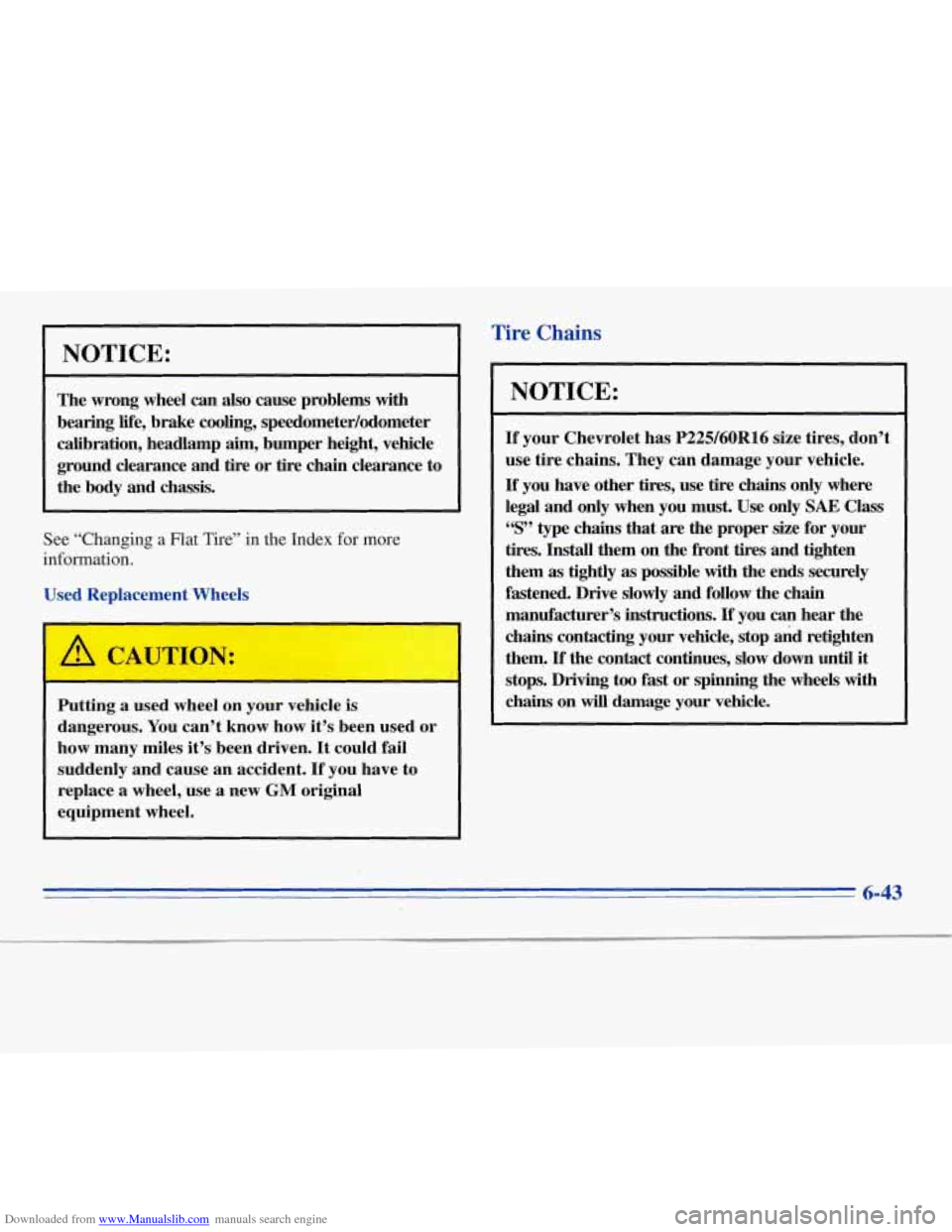Page 188 of 340

Downloaded from www.Manualslib.com manuals search engine Rea
to the - lant
rank
If you haven’t found a problem yet, but the coolant level
isn’t at
the COLD mark, add a 50/50 mixture of
clean water (preferably distilled) and DEX-COOL TM
(orange-colored, silicate-free) antifreeze at the coolant
recovery tank. (See “Engine Coolant” in the
Index for
more information.)
Adding only plain water to your cooling system
can be dangerous. Plain water, or some other
liquid like alcohol, can boil before the proper
coolant mix will. Your vehicle’s coolant warning
system is set for the proper coolant mix. With
plain water or the wrong mix, your engine could
get too hot but
you wouldn’t get the overheat
warning. Your engine could catch fire and you or
others could be burned. Use a
50/50 mix of clean
water and
DEX-COOL TM antifreeze.
1 NOTICE:
In cold weather, water can freeze and crack the
engine, radiator, heater core and other parts. Use the recommended coolant and the proper
coolant mix.
5-16
Page 189 of 340
Downloaded from www.Manualslib.com manuals search engine You can be burned if you spill coolant on hot
engine parts. Coolant contains ethylene glycol
and it will burn if the engine parts are hot
enough. Don't spill coolant on a hot engine.
When the coolant in the coolant recovery tank is at the
COLD mark, start your vehicle.
If the overheat warning continues, there's one more
thing you can try.
You can add the proper coolant mix
directly to the radiator, but
be sure the cooling system is
cool before you do it.
I CAUTION: I
Steam and scalding liquids from a hot cooling
system can blow out and burn you badly. They
are under pressure, and if you turn the radiator
CAUTION: (Continued) 7AU'l'ION:
(Continued)
pressure cap
-- even a little -- they can come out
at high speed. Never turn the cap when the
cooling system, including the radiator pressure
cap, is hot. Wait for the cooling system and
radiator pressure cap to cool if you ever have to
turn the pressure cap.
5-17
Page 190 of 340
Downloaded from www.Manualslib.com manuals search engine v ti
I NOTICE:
lant to the ldiator
Your engine has a specific radiator fill procedure.
Failure to follow this procedure could cause your
engine to overheat and be severely damaged.
1. You can remove the
radiator pressure cap
when the cooling
system, including the
radiator pressure
cap and
upper radiator hose, is
no longer hot.
Turn the pressure cap slowly counterclockwise until it first
stops. (Don’t press down while turning the pressure
cap.)
If you hear a hiss, wait for that to stop. A hiss means
there
is still some pressure left.
2. Then keep turning
the pressure cap, but
now push down as
you
turn it. Remove the
You can be burned if‘ you spill coolant on hot
engine parts. Coolant contains ethylene glycol
and it
will burn if the engine parts are hot
enough. Don’t spill coolant on a hot engine.
5-18
Page 227 of 340

Downloaded from www.Manualslib.com manuals search engine How to Add Fluid Engine Coolant
Refer to the Maintenance Schedule to determine what
kind
of transaxle fluid to use. See “Recommended
Fluids and Lubricants”
in the Index.
If the fluid
level is low, add only enough of the proper
fluid to bring the level into the cross-hatched area on
the dipstick.
1. Pull out the dipstick.
2. Using a long-neck funnel, add enough fluid at the
dipstick hole to bring
it to the proper level. It doesn’t
take much fluid, generally less than
a pint (OSL).
Don ’t overfill. We recommend you use only fluid
labeled DEXRON@-111, because fluid with that
label is made especially for your automatic transaxle.
Damage caused by fluid other than DEXRON@-I11
is
not covered by your new vehicle warranty.
0 After adding fluid, recheck the fluid level as
described under “How to Check.”
0 When the correct fluid level is obtained, push the
dipstick back
in all the way. The cooling
system in your vehicle is filled with new
DEX-COOL
TM (orange-colored, silicate-free) engine
coolant. This coolant is designed
to remain in your
vehicle for
5 years or 100,000 miles ( 166 000 km),
whichever occurs first.
The following explains your cooling system and how
to
add coolant when it is low. If you have a problem with
engine overheating
or if you need to add coolant to your
radiator, see “Engine Overheating”
in the Index.
A 50/50 mixture of water and the proper coolant for
your Chevrolet will:
0 Give freezing protection down to -34°F (-37°C).
0 Give boiling protection up to 265°F (129°C).
Protect against rust and corrosion.
0 Help keep the proper engine temperature.
0 Let the warning lights and gages work as they
should.
Page 228 of 340

Downloaded from www.Manualslib.com manuals search engine NOTICE:
When adding coolant it is important that you use
DEX-COOL
TM (orange-colored, silicate-free)
coolant meeting
GM Specification 6277M.
If silicated coolant is added to the system,
premature engine, heater core or radiator
corrosion may result. In addition, the engine
coolant will require change sooner
-- at
30,000 miles (50 000 km) or 24 months
whichever occurs first.
What to
Use
Use a mixture of one-half clean water (preferably
distilled) and one-half
DEX-COOL TM (orange-colored,
silicate-free) antifreeze that meets
GM Specification
6277M, which won’t damage aluminum parts. Use
GM Engine Coolant Supplement (sealer) (GM Part
No. 3634621) with any complete coolant change. If you
use this mixture, you don’t need to add anything else.
Adding only plain water to your cooling system
can be dangerous. Plain water, or some other
liquid like alcohol, can boil before the proper
coolant mix will. Your vehicle’s coolant warning
system is set for the proper coolant mix. With
plain water or the wrong mix, your engine could
get too hot but you wouldn’t get the overheat
warning. Your engine could catch fire and you or
others could be burned.
Use a 50/50 mix of clean
water and DEX-COOL
TM (orange-colored,
silicate-free) antifreeze.
Page 229 of 340
Downloaded from www.Manualslib.com manuals search engine NOTICE:
If you use an improper coolant mix, your
engine could overheat and be badly damaged.
The repair cost wouldn’t be covered by your
warranty.
Too much water in the mix can freeze
and crack the engine, radiator, heater core and
other parts.
If you have to add coolant more than four times a year,
have your dealer check your cooling system.
I NOTICE:
If you use the proper coolant, you don’t have to
add extra inhibitors or additives which claim to
improve the system. These can be harmful.
Checking Coolant
r-
When your engine is cold, the coolant level should be at
the
COLD mark or a little higher. When .your engine is
warm,
the level should be up to the HOT mark or a
little higher.
6-21
Page 251 of 340

Downloaded from www.Manualslib.com manuals search engine NOTICE:
The wrong wheel can also cause problems with
bearing life, brake cooling, speedometer/odometer
calibration, headlamp aim, bumper height, vehicle
ground clearance and
tire or tire chain clearance to
,the body and chassis.
I I
See “Changing a Flat Tire” in the Index for more
information.
Used Replacement Wheels,
Tire Chains
Putting a used wheel on your vehicle is
dangerous.
You can’t know how it’s been used or
how many miles it’s been driven.
It could fail
suddenly and cause an accident.
If you have to
replace a wheel, use
a new GM original
equipment wheel.
NOTICE:
If your Chevrolet has P22960Rl6 size tires, don’t
use tire chains. They can damage your vehicle.
If you have other tires, use tire chains only where
legal and only when you must. Use only
SAE Class
“S” type chains that are the proper size for your
tires.
Install them on the front tires and tighten
them as tightly as possible with the ends securely
fastened. Drive slowly and follow the chain
manufacturer’s instructions.
If you can hear the
chains contacting your vehicle, stop
&d retighten
them.
If the contact continues, slow down until it
stops. Driving too fast or spinning the wheels with
chains on
will damage your vehicle.
6-43
Page 265 of 340
Downloaded from www.Manualslib.com manuals search engine Fuse
F/INJN
ECM IGN
ELEK IGN
10
11
12
13
Description
Fuel Injectors, High Resolution
24X Crankshaft Position Sensor,
Camshaft Position Sensor
Powertrain Control Module (PCM),
Mass Air Flow (MAF) Sensor
(VIN
X only), EGR, CCP, qxygen Sensor,
VAC CAN
SW, Fan #2 Relay
Electronic Ignition
(EI)
Control Module
I/P Fuse Block
FAN CONT
#I Relay
Passenger’s Side Underhood
Electrical Center and
IJP Fuse
Blocks: Fuses
5, 14,23 and 32
FAN CONT #2 Relay and I/P Fuse
Block: Fuse 16, Power Seat
Circuit Breaker D
Relay
14
15
16
17
18
Description
FUEL PUMP
A/C CMPR
FAN CONT #2
-- Secondary
Cooling Fan (Passenger’s Side)
FAN CONT
#I -- Primary
Cooling Fan (Driver’s Side)
Ignition Relay
6-57